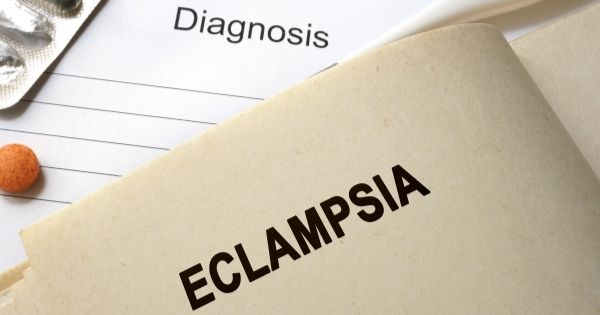You may have heard the term pre-eclampsia before but are not sure about what exactly this condition entails or how serious it could get if left untreated. In this article, we will be telling you everything there is to know about pre-eclampsia, so that you know what to look and what you can do to prevent this condition from developing during your pregnancy.
***Disclosure -The links in this post may contain affiliate links and I may receive a small commission if you make a purchase after clicking on a link.***

What is pre-eclampsia?
Pre-eclampsia is usually diagnosed when you experience high blood pressure and protein in your urine while being pregnancy or sometimes after delivery. You may also have platelets (clotting factors) present in your blood or signs of liver or kidney issues. Pre-eclampsia typically occurs after the twentieth week of pregnancy, but in some instances, it can happen earlier, or after delivery of your baby.
Eclampsia is a severe form of pre-eclampsia that usually involves seizures due to high blood pressure. Similar to pre-eclampsia, eclampsia sets in during pregnancy, and sometimes after delivery. About five percent of all pregnant moms experience pre-eclampsia.
Pre-eclampsia vs. eclampsia
Both pre-eclampsia and eclampsia are the result of high blood pressure during pregnancy, and form part of hypertensive disorders that happen when you are pregnant. Gestational hypertension happens when a woman had normal blood pressure before but developed high blood pressure after the twentieth week of pregnancy, but it subsides within twelve weeks of giving birth. Gestational hypertension usually happens without any other symptoms and is generally not dangerous to the mom or baby.
Pre-eclampsia is like gestational hypertension since it entails high blood pressure during or after twenty weeks of pregnancy in women who generally had normal blood pressure prior to pregnancy. However, pre-eclampsia can involve blood pressure at 140/90mmHG, or higher protein in the urine, and increased swelling. This condition could be serious and is the main cause of pre-term birth. A severe case of pre-eclampsia can impact brain function which can result in a coma or seizures and is referred to as eclampsia.
A highly severe complication of hypertensive disorders during pregnancy is called HELLP syndrome which happens when pregnant women with pre-eclampsia or eclampsia also experience damage to their blood cells and liver. This condition is life-threatening and must be addressed immediately.
Pre-eclampsia definition
Pre-eclampsia, also referred to as toxemia, is a potentially threatening complication during pregnancy which is characterised by hypertension (high blood pressure). Pre-eclampsia typically sets in after twenty weeks of pregnancy in women who had normal blood pressure before. It can result in severe, sometimes fatal, complications for the baby and mother. In some cases, there might not be any symptoms.
Protein in your urine and high blood pressure are primary features and sometimes you may also experience water retention and swelling in your legs. But this is often hard to differentiate from normal pregnancy. Pre-eclampsia is often times managed through IV or oral medication until the baby is sufficiently developed to be born. This often involves weighing the risks of premature delivery against the risk of ongoing pre-eclampsia symptoms.
What are the causes of pre-eclampsia?
There are not yet a specific cause of pre-eclampsia, however some possible causes exist, which include:
- Genetic reasons
- Autoimmune disorders
- Blood vessel issues
There are certain risk factors also that could amplify the chances of getting pre-eclampsia. These include:
- Expecting multiple babies
- Being older than 35 years old when pregnant
- Being pregnant during your early teens
- Being your first pregnancy
- Being overweight or obese
- A history of high blood pressure
- A history of diabetes
- A history of kidney disorder in your family
There is nothing you can do to definitely avoid this condition; however, physicians might prescribe that certain women take baby aspirin after the first trimester to help with prevention. Early and ongoing prenatal care can assist doctors with diagnosing the condition quicker and prevent complications. Once a diagnosis is made, the doctor can monitor you and the baby until your delivery date.

Pre-eclampsia symptoms
If you had more than one blood pressure measurement higher than 140/90mm Hg within four hours apart in conjunction with a history of hypertension, it is possible you have pre-eclampsia. The rise in blood pressure can happen suddenly without warning. Other symptoms linked to pre-eclampsia include:
- Having trouble breathing
- Nausea
- Shortness of breath
- Unexpected weight gain
- Severe headaches
- Swelling of your hands and face
- Excess protein in your urine that can result in kidney problems
- Changes in your vision like blurry vision, light sensitivity, or impermanent loss of vision
- Vomiting
It is imperative to seek medical treatment immediately after experiencing any of such symptoms. Women might initially associate these symptoms with normal pregnancy symptoms. However, if at any point you suspect that you may experience pre-eclampsia, the safe choice would be to consult your doctor to avoid severe complications.
What are possible risk factors for pre-eclampsia?
Pre-eclampsia typically develops as a complication of pregnancy and the risk factors are:
Previously having pre-eclampsia – a family or individual history of pre-eclampsia substantially increase the risk of getting pre-eclampsia.
Chronic high blood pressure – if you are already suffering from chronic high blood pressure, you are at risk of contracting pre-eclampsia.
This is your first pregnancy – the risk of getting pre-eclampsia is most predominant during a first pregnancy.
New paternity – every pregnancy with a new partner intensifies the risk of pre-eclampsia, more than a second or third pregnancy from the same partner.
Multiple pregnancy – pre-eclampsia often occurs in women who are expecting multiples.
Race – black women have a greater risk of getting pre-eclampsia than the case is with pregnant women of other races.
Age – if you are pregnant and older than 35, you are at risk of getting pre-eclampsia.
Short interval between pregnancies – expecting babies shorter than two years or exceeding ten years apart, can increase the risk of getting pre-eclampsia.
Obesity – women who are obese have a higher risk of developing pre-eclampsia.
In vitro fertilization – the risk of developing pre-eclampsia is more substantial if your little one was conceived through in vitro fertilization.
A history of particular health conditions – if you have a history of particular health conditions prior to becoming pregnant, for example, hypertension, type 1 and 2 diabetes, migraines, lupus, kidney disease, or a tendency of developing blood clots, your risk of pre-eclampsia is greater.
Pre-eclampsia treatment
The most common treatment for pre-eclampsia is delivering the baby since in the majority of cases, it helps prevent advancement of the disease.
Delivery
If you are in your 37th week or later in pregnancy, your physician might induce labor since at this point, a baby has developed sufficiently and is not considered premature. If your pre-eclampsia starts developing prior to 37 weeks, then your doctor must think about you and your baby’s health in deciding on the delivery time. This is contingent on various factors, that include the baby’s gestational age, how severe the pre-eclampsia has become, and whether or not labor has started.
Delivering your little one and the placenta should clear up the condition.
How can physicians regulate your blood pressure?
Your physician will take into consideration how far along your pregnancy is and the development of your baby when deciding the best way to regulate your blood pressure. If you are passed the 37 weeks of pregnancy, delivery of the baby and placenta is the best way to go to prevent further progression of pre-eclampsia. If the baby is not yet sufficiently developed, the doctor might prescribe medicines that are designed for helping baby develop while regulating your blood pressure at the same time.
These may involve:
- Blood pressure-lowering meds
- Corticosteroids which help your baby’s lungs to mature while lessening inflammation in your liver.
- Medications for reducing seizures and magnesium sulfate
In many cases, these meds are administered in hospital. While bed rest is one way of reducing high blood pressure, the doctors can also closely monitor you and the baby while in hospital.

Pre-eclampsia treatment after delivery
Usually after your baby is born, the pre-eclampsia symptoms should resolve. Most women’s blood pressure levels return to normal 48 hours after giving birth. For most the symptoms disappear and their kidney and liver function go back to normal within a few months. But, in some instances, blood pressure can raise again a few days after giving birth. That is why follow-up care with your physician is critical and frequent blood pressure checks must be done after the birth of your baby.
Although not common, pre-eclampsia can happen after giving birth, with a normal pregnancy. That is why it is imperative to keep seeing your doctor after an uncomplicated pregnancy if you experience any of the symptoms mentioned earlier.
Dangers of pre-eclampsia
Complications arising because of pre-eclampsia might include:
Fetal growth restriction – pre-eclampsia impacts the arteries that carry blood to your placenta. If your placenta is not getting sufficient blood, the baby will receive a shortage of oxygen, blood and nutrients which are essential for fetal growth. This could result in low birth weight or premature birth.
Premature birth – If you experience pre-eclampsia with severe properties, you might have to deliver your baby early to save both your lives. Premature birth can result in difficulty breathing and other issues for the baby. Your doctor will decide which time is the most appropriate for delivery.
Placental abruption – pre-eclampsia amplifies the risk of placental abruption which is a condition that involves your placenta separating from the inner wall of the uterus before giving birth. Severe abruption can cause heavy bleeding. This is life threatening to both you and your baby.
HELLP Syndrome – stands for hemolysis (destruction of red blood cells) elevated liver enzymes and low platelet count. This condition is a severe form of pre-eclampsia and can quickly become life-threatening for the baby and the mom. Symptoms of HELLP syndrome involves vomiting and nausea, abdominal pain on the upper right side, and headache. This condition is especially dangerous since it can cause damage to a few organ systems in your body. It may develop quickly in some instances, even before hypertension is detected or it might develop without experiencing any symptoms.
Eclampsia – if pre-eclampsia is not regulated, eclampsia can set in which is essentially pre-eclampsia with accompanying seizures. It is incredibly tricky to pre-determine which patients will experience pre-eclampsia that becomes severe enough to progress to eclampsia. It happens often that the patient notices no warning signs or experience symptoms that indicate eclampsia. Since eclampsia can lead to severe consequences for both you and your baby, delivery becomes the only solution, irrespective of how far along your pregnancy is.
Damage to other organs – pre-eclampsia might result in damage to your heart, kidneys, eyes, liver, or lungs, and might result in a stroke or another brain injury. The total of injury to other organs is contingent on the seriousness of pre-eclampsia.
Cardiovascular disease – if you have pre-eclampsia, the risk of future cardiovascular (heart and blood vessel) disease is higher. The risk is even more predominant if you had pre-eclampsia on more than once occasion or you had preterm delivery. To lower this risk, it is best to maintain healthy weight, eat plenty of fruits and vegetables, exercise frequently, and do not smoke after delivery. If you experience any of the symptoms linked to pre-eclampsia, you must contact your doctor right away, to avoid any further complications that could have dire consequences.
What is the prognosis for those with pre-eclampsia?
If your pregnancy has progressed far enough to give birth, your blood pressure should return to normal after delivery. In some cases, it could take about three months, however, in most instance, the doctor will do whatever he can to help your baby develop sufficiently to be brought into this world safely.
Can pre-eclampsia be prevented?
If you already have a history of having pre-eclampsia, it is essential to take certain steps to make sure you are healthy before conceiving. This involves losing weight if you are obese, lowering high blood pressure, and regulating your diabetes, if necessary. Your physician may prescribe various preventative steps if you are at risk of pre-eclampsia or had it previously. This may include:
- Taking low-dose aspirin (between 60 and 81mg).
- Frequent prenatal care so that pre-eclampsia can be detected as early on as possible.
It is of utmost importance to keep to frequent doctor’s appointments to check your urine and blood pressure levels frequently.
Conclusion
We hope you have found this article informative. Pre-eclampsia can be regulated, and your blood pressure controlled when it is detected early on. It is essential that pre-eclampsia is addressed as soon as possible to prevent any complications that could be life-threatening for you and your little one.
 Kaboutjie SA Mommy Blogs by Lynne Huysamen
Kaboutjie SA Mommy Blogs by Lynne Huysamen





Interesting read. I had it with my first and the second one we took the necessary precautions to make sure that i don’t get it again. Did suffer from hypertension with the second one
Very informative article.I gave birth 2yrs ago to my lastborn(I had just turned 35), at about 7months I had a higher level of protein in my urine, received antibiotics,which I could not use as I was allergic to penicillin,so at my next check up a different doc gave me a different antibiotic,I completed it and checking in for my scheduled c-section,I still had a high level of protein.Bloodtests were taken as doc suspected Pre-eclampsia and the morning of my c-section,Thank God it was booked for 37.5 weeks the machine showed signs of labour,but I had no pains.2 yrs later I still am not sure if it was Pre-eclampsia,but my lastborn weighed significantly less than my 1st born.He was 2.9kg vs his older brother who weighed 3.53kg.